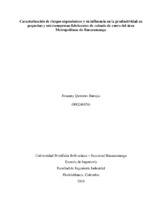Caracterización de riesgos ergonómicos y su influencia en la productividad en pequeñas y microempresas fabricantes de calzado de cuero del área Metropolitana de Bucaramanga
Fecha
2018Director/Asesor
Castañeda Galvis, María Teresa
Tipo de contenido
Práctica
Citación
Metadatos
Mostrar el registro completo del ítemDocumentos PDF
Resumen
El actual proyecto constituye un esfuerzo para difundir como temas ergonómicos son trascendentales para la mejora indiscutible de una actividad laboral, debido al riesgo osteomuscular latente en el recurso humano. Con el fin de proponer una línea de acción que permita a las empresas el mejoramiento de su sistema productivo, para esto se inicia con un diagnóstico para identificar qué factores de riesgo están expuestos, es decir cuáles son las condiciones del entorno de trabajo, las tareas realizadas y la exigencia de estas, los factores físicos biomecánicos (postura, movimientos repetitivos, manipulación de cargas, entre otros). Posteriormente se realiza la evaluación de los factores de riesgo encontrados, por medio del Método Rula, el cual representa el medio más adecuado para brindar información sobre el nivel de riesgo, de igual modo se registra el nivel de productividad actual. Por consiguiente, se jerarquizan los riesgos encontrados, sus respectivos niveles y la prioridad que tienen de ser intervenidos. Finalmente, se proponen y aplican mejoras que permiten observar el cambio en la productividad, debido a cambios ergonómicos que favorecen el bienestar del trabajador. The current project is an effort to disseminate how ergonomic issues are important for the indisputable improvement of a work activity, due to the latent musculoskeletal risk in human resources. In order to propose a line of action that allows companies to improve their productive system, this starts with a diagnosis to identify which risk factors are exposed, ie what are the conditions of the work environment, the tasks performed and the requirement of these, biomechanical physical factors (posture, repetitive movements, cargo handling, among others). Subsequently, the assessment of the risk factors found is carried out, by means of the Rula Method, which represents the most appropriate means to provide information on the level of risk, in the same way the current level of productivity is recorded. Therefore, the risks found, their respective levels and the priority they have to be intervened are hierarchized. Finally, improvements are proposed and applied to observe the change in productivity, due to ergonomic changes that favor the well-being of the worker.
Colecciones
- Trabajos de grado [6698]
El ítem tiene asociados los siguientes ficheros de licencia:


